Question: If social media is a continuum what are its characteristics?
Social media is best understood as a group of new kinds of online media, which share most or all of the following characteristics:
Participation.
Social media encourages contributions and feedback from everyone who is interested. It blurs the line between media and audience.
Openness
Most social media services are open to feedback and participation. They encourage voting, comments and the sharing of information. There are rarely any barriers to accessing and making use of content – password-protected content is frowned on.
Conversation
Whereas traditional media is about“broadcast”(content transmitted or distributed to an audience) social media is better seen as a two-way conversation.
Community
Social media allows communities to form quickly and communicate effectively. Communities share common interests, such as a love of photography, a political issue or a favourite TV show.
Connectedness
Most kinds of social media thrive on their connectedness, making use of links to other sites, resources and people.
What is and what is not social media, and how does it relate to other terms like web 2.0, eMarketing, or word of mouth marketing?
Social media, on the other hand, is a two-way street that gives you the ability to communication.
In Web 2.0, Social media is a website. at the same time, which is a two-way street that gives you the ability to communication. Which can be use to vote an article or share a funny movie trailer.
What are some of the examples of social media used for marketing and how does their use differ?
Friendster: A way to stay connected with everything that’s important to you — hobbies, interests, causes, business, etc. Strengths: A simple web-interface makes this easy-to-use. Weaknesses: Not as widely adopted as some other platform-runs. Might have peaked.
hi5: This is a social networking platform that skews a little younger than LinkedIn. Members can play games, watch videos, flirt, give gifts or just hang out. Strengths: It’s a great alternative to MySpace and/or Facebook for the younger crowd. Weaknesses: It may not be the best social networking platform for business.
LinkedIn: This is the Grand Pooh Bah of them all. They’ve been around since 2003, which, in social media terms is also known as “since the beginning of time.” Strengths: Everybody’s on LinkedIn. Weaknesses: Most people have trouble knowing what to do with LinkedIn after they upload their business information.
Meerkat: This live streaming social media platform is perfect for people who want to share videos of the special moments in their lives. Perfect for business, social networking, or for close friends, this mobile-only social network is growing quickly and rapidly. (Check out our Meerkat vs. Periscope comparison by clicking here.)
Question: Read Chialdini (Chapter 7 Scarcity) and share your opinion on parental control for Social Media. Is it a good idea? Will it work?
As the network information is uneven, there is a lot of information that contains violence, pornography and the like. The impact on children is enormous, so Cialdini is very necessary. Even harmful information were blocked, some criminals will harm their children in the online world by inadvertently leaked the information.
Question: How can reactance theory be used to advantage by marketers? Can you think of a few real life examples?
When the freedom of consumers threatened they felt unwell, so they may not be expected to behave in a defensive way for marketing. Therefore, marketers should be aware of this, and not a threat to freedom that they are trying to attract consumers.



 YouTube
YouTube